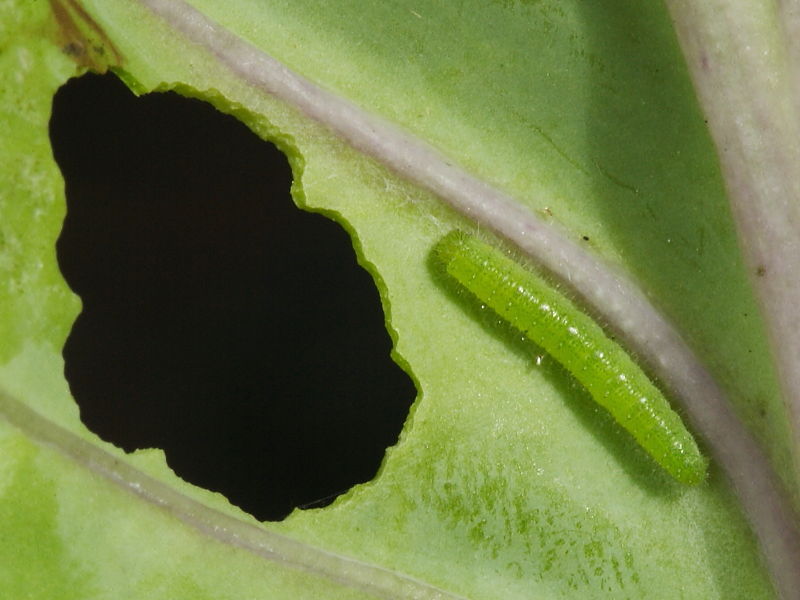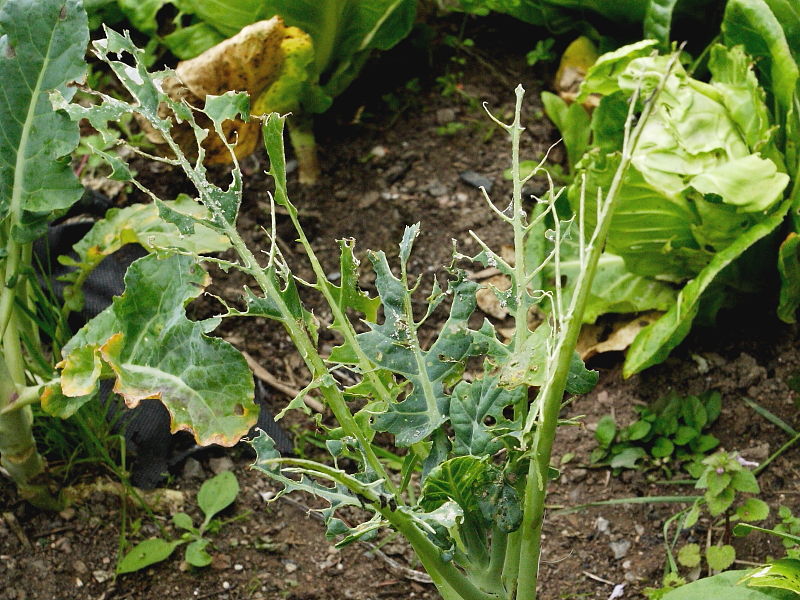
The caterpillars of the white butterfly, (moth), are the true scourge of growing all of the brassicas. These include cabbage, kale, brussel sprouts, cauliflower and broccoli and mustard leaves. You can also include the Asian greens of pak choi, bok choi and wonbok.
The butterflies’ progeny, small luminous green caterpillars, are rapacious eaters, and in a single night, the brassica’s leaves can be shredded, resembling Swiss cheese, bare skeletons, devoured right back to their bare leaf ribs. Their eggs are laid en masse on the leaves, and before you know it, you have an explosion of caterpillars, an invasion of biblical numbers.
The larvae pupate in open-weave cocoons stuck to the leaves, from which the next generation of adult butterflies emerge. The entire life cycle can be completed in as little as three weeks
Interestingly, “the white butterflies have the curious ability to taste the quantity of mustard in a plant, the principle being the stronger the taste, the better host for their eggs. The curiosity factor in this is that the brassica plant developed the mustard taste as a defence against insects. The butterflies in turn take on the same mustard taste in their own tissues, which works effectively against predation by birds.” Monty Don.
Regardless of their damage, I still admire the white butterfly’s acrobatic agility in flight. They are a delight to watch, when they whip, weave and wheel, dip, flit, flip and flutter, a dance like an aerial ballet of extraordinary beauty. I love to watch them for a few minutes each day. But seeing and remembering the evidence of their destruction on my brassicas, my admiration quickly evaporates and my murderous behaviour kicks back in. The survival of the fittest and all that.
In heart of winter the butterfly is not a problem, but its autumn leadup and the following spring and summer are when the butterfly is most prevalent and dangerous.

So how can we deal with them?
Firstly
• My first choice in their control is to pick them out by hand, however this is not that effective for they are very small and hide in the dense foliage during the day.
• The best overall long term solution is to net the bed with a material with small enough holes to prevent the butterfly reaching the brassicas plants. something like a mosquito net.
Secondly – The Commercially available products
• Dipel a biological spray of Bacillus Thuringiensis var. Kurstaki which only affects caterpillars and so is safe for bees, ladybirds, birds and animals. Repeat weekly.
• Derris Dust made from the roots of the derris plant. Apply at night when the caterpillars are active and wash off in the morning. The dust also kills aphids and slugs so I suppose they may well kill ladybirds etc. There is a one day withholding period where you cannot eat the produce. Repeat weekly.
Thirdly – Companion Planting.
• My research has suggested the plantings of thyme, rosemary, sage, wallflower, wormwood, mint, basil and tomatoes to reduce the proliferation of butterfly. In my own experience none help in the least for I already have all these plants surrounding and interplanted with my brassicas.
• However there are two which work effectively,
• The broccoli is under planted with land cress, itself a great salad leaf to grow. The butterflies believe it is the very best and tastiest of all the brassicas and when then diverted they lay their eggs on them instead. When the caterpillars appear they are concentrated on the land cress stripping it bare first and thus you know there will be an imminent explosion of the butterfly and easier to step up manage the problem.
• Plantings of the herb dill. Brassicas support the floppy stems of dill. The tall fuzzy foliage helps camouflage the brassica leaves, their odorous foliage masks the scent of the brassicas, and the dill flowers attract beneficial predators that attack grubs.

Fourthly – Eco-friendly home-made remedies.
Some are highly effective, others only partially. All should be applied early evening and weekly.
• A spray of sour milk on the leaves deters the butterflies.
• A spray of glutinous garlic/soap solution prevent butterflies from laying eggs.
• Gather a few older leaves from your brassicas, add a couple of cups of hot water, blend and strain the mixture and let it cool before spraying on your plants. The butterflies cannot stand the rank smell of rotting leaves and go elsewhere.
• If you have indeed hand-picked the caterpillars then if you have a reasonable quantity, say ten or so, follow the previous recipe and spray. The butterflies again cannot stand the stench of their own dead caterpillars.
• Throw old brassica leaves on the ground and fertilise with Rooster Booster on top and water them. The slowly rotting leaves again deter the caterpillars and will eventually become a nutritious fertilised mulch.
• Other reported spray remedies may be made from the leaves of rhubarb, geranium, potatoes, tomatoes and if you can find a smoker nicotine. Yet not tested
• Sprinkling of wood ashes and salt are said to prevent eggs hatching.
• Good old plain flour, the caterpillars ingest the flour, it swells and sets in their stomach and they die. This is the easiest and most economically efficient method of the lot. But beware the combination of flour and water creates a paste, so a thorough washing off of the flour the next morning is mandatory.
• Pepper on sprinkled on wet brassica leaves deters caterpillars.
• Large eggshells placed around brassicas with the white side up or thread eggshells onto string or fishing line and hang it above your vegies to keep them away. The butterfly believes the white eggshells are other butterflies, and thus will not lay its eggs and will continue flying elsewhere.
• When planting brassicas, mix 1 teaspoon of sulphur in the soil, reducing the mustard taste and the new leaf growth makes it most unattractive to butterflies. The leaves may become slightly yellow but are they are still great quality eating.
• And now for my favourite method. I play a lot of tennis. When outside gardening I always have my racquet on hand. Who needs an advancing tennis ball when I have a target of countless white butterflies to chase. Swinging left and right, high and low, at times quite madly, trying to swat the little buggers with their wild looping and acrobatic flight patterns. It’s great for my tennis game lifts my aerobic activity and drastically reduces the butterflies numbers.
I would truly appreciate any feedback of the effectiveness of these mentioned methods or any other alternate suggestions which you have found successful.
Good luck, have fun and happy planting, but in this case happy killing.
Regards Ned McDowell